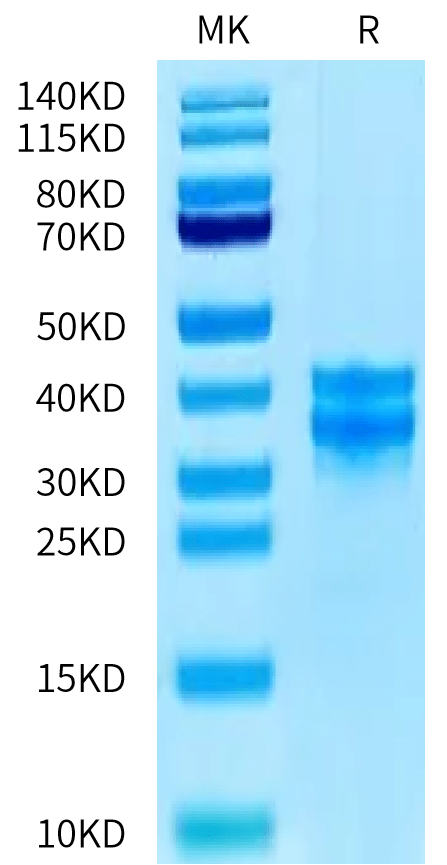| Weight | 1 lbs |
|---|---|
| Dimensions | 9 × 5 × 2 in |
| accession | Q96KB5 |
| express system | Baculovirus-Insect Cells |
| product tag | C-His |
| purity | > 95% as determined by Tris-Bis PAGE |
| background | T-lymphokine-activated killer cell-originated protein kinase (TOPK, also known as PDZ-binding kinase or PBK) plays a crucial role in cell cycle regulation and mitotic progression. Abnormal overexpression or activation of TOPK has been observed in many cancers, including colorectal cancer, triple-negative breast cancer, and melanoma, and it is associated with increased development, dissemination, and poor clinical outcomes and prognosis in cancer. Moreover, TOPK phosphorylates p38, JNK, ERK, and AKT, which are involved in many cellular functions, and participates in the activation of multiple signaling pathways related to MAPK, PI3K/PTEN/AKT, and NOTCH1. |
| molecular weight | The protein has a predicted MW of 37.61 kDa. Due to glycosylation, the protein migrates to 38-45 kDa based on Tris-Bis PAGE result. |
| available size | 100 µg, 500 µg |
| endotoxin | Less than 1EU per μg by the LAL method. |
Human PBK/TOPK Protein 2350
$315.00 – $1,050.00
Summary
- Expression: Baculovirus-Insect Cells
- Pure: Yes (SDS-PAGE)
- Amino Acid Range: Met1-Val322
Human PBK/TOPK Protein 2350
| protein |
|---|
| Size and concentration 100, 500µg and lyophilized |
| Form Lyophilized |
| Storage Instructions Valid for 12 months from date of receipt when stored at -80°C. Recommend to aliquot the protein into smaller quantities for optimal storage. Please minimize freeze-thaw cycles. |
| Storage buffer Shipped at ambient temperature. |
| Purity > 95% as determined by Tris-Bis PAGE |
| target relevance |
|---|
| T-lymphokine-activated killer cell-originated protein kinase (TOPK, also known as PDZ-binding kinase or PBK) plays a crucial role in cell cycle regulation and mitotic progression. Abnormal overexpression or activation of TOPK has been observed in many cancers, including colorectal cancer, triple-negative breast cancer, and melanoma, and it is associated with increased development, dissemination, and poor clinical outcomes and prognosis in cancer. Moreover, TOPK phosphorylates p38, JNK, ERK, and AKT, which are involved in many cellular functions, and participates in the activation of multiple signaling pathways related to MAPK, PI3K/PTEN/AKT, and NOTCH1. |
| Protein names Lymphokine-activated killer T-cell-originated protein kinase (EC 2.7.12.2) (Cancer/testis antigen 84) (CT84) (MAPKK-like protein kinase) (Nori-3) (PDZ-binding kinase) (Spermatogenesis-related protein kinase) (SPK) (T-LAK cell-originated protein kinase) |
| Gene names PBK,PBK TOPK |
| Protein family Protein kinase superfamily, STE Ser/Thr protein kinase family, MAP kinase kinase su |
| Mass 9606Da |
| Function Phosphorylates MAP kinase p38. Seems to be active only in mitosis. May also play a role in the activation of lymphoid cells. When phosphorylated, forms a complex with TP53, leading to TP53 destabilization and attenuation of G2/M checkpoint during doxorubicin-induced DNA damage. |
| Catalytic activity #N/A |
| Tissues Expressed in the testis and placenta. In the testis, restrictedly expressed in outer cell layer of seminiferous tubules. |
| Structure Interacts with DLG1 and TP53. |
| Post-translational modification Phosphorylated; in a cell-cycle dependent manner at mitosis. |
| Target Relevance information above includes information from UniProt accession: Q96KB5 |
| The UniProt Consortium |
Publications
Publications
| pmid | title | authors | citation |
|---|---|---|---|
| We haven't added any publications to our database yet. | |||
Protocols
| relevant to this product |
|---|
Documents
| # | ||
|---|---|---|
| Please enter your product and batch number here to retrieve product datasheet, SDS, and QC information. | ||















